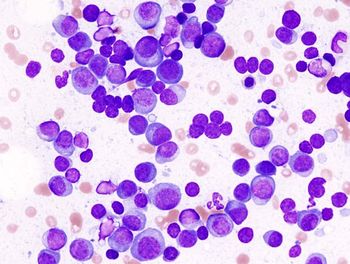
Overview on Risk Stratification in Multiple Myeloma
Opening its discussion on the management of multiple myeloma, a panel of experts from Ochsner Health reviews risk stratification strategies via NCCN and mSMART guidelines.
Episodes in this series

Transcript:
Andrew P. Dalovisio, MD: Good evening. My name is Andy Dalovisio. I’m one of the hematologists and stem cell transplant physicians at Ochsner [Health] in New Orleans, [Louisiana,] specializing in plasma cell disorders. Tonight, we’ll be discussing the evolving treatment landscape of multiple myeloma [MM] for this Cancer Network satellite session, and I’d like to introduce the panel that’ll be with us tonight. You guys can go ahead.
Ernest C. Quintin, MD: Hi, my name is Ernest Quintin. I’m a general hematologist oncologist. I work for Ochsner Health in Houma, Louisiana.
Thomas Atkinson, MD: My name is Thomas Atkinson. I am a hematologist oncologist. I’m practicing at Ochsner Health in Kenner, Louisiana.
Kelly Pippin, MD: I’m Kelly Pippin. I’m one of the hematologist oncologists at St Tammany Cancer Center in Covington, Louisiana.
Ryan P. Griffin, MD: Hi. I’m Ryan Griffin. I’m one of the hematologist oncologists practicing at Ochsner Health in Kenner in St Charles Parish Hospital in Kenner, Louisiana.
Andrew P. Dalovisio, MD: The objective of tonight is to get a number of the doctors from different Ochsner locations together to talk about the MM field that I see most patients in and there's a lot of exciting stuff happening. For the talk tonight, I'll break it down into 2 main sections. The first section will be broken down into 3 sections where we'll talk about transplant-eligible disease briefly, then we'll talk about transplant-ineligible disease treatment, and then the second third of the first half, we'll talk about relapsed refractory disease, which there's a lot of exciting stuff happening. For the second part of the conversation tonight, we'll talk about some cases we can go through just to hopefully, apply some of the stuff we're learning tonight. I'd like to thank everyone for coming here tonight
The first module we're going to talk about is the evolving treatment landscape in transplant-eligible MM.I think one of the things I'd like to start with is just a little bit of a Q&A, of how we risk-stratify patients, because I think, throughout the talk tonight, that's going to really pepper some of the approaches we take and how they may differ in different disease settings. So I want to pose it to you guys. Is there a specific staging system that you guys use? Is it mSMART [Stratification for Myeloma and Risk-Adapted Therapy], NCCN [The National Comprehensive Cancer Network], or IMWG [International Myeloma Working Group] when you're approaching your patients, and maybe I'll start with Ernest on that one?
Ernest C. Quintin, MD: I don't know how the other oncologists feel about this, but I feel like I'm always living with the NCCN. I think it is a nice up-to-date article always, even from a risk stratification standpoint. I'm usually using whatever that source is that the NCCN provides, for sure.
Ryan P. Griffin, MD: Yeah, I think I go with the mSMART criteria because it helps me get a sense of how concerned I should be about this patient. I refer all patients to one of the transplanters at our main hospital, but I'm wondering if someone's high risk, they have any of the main things like 4;14, 14;20, 17p deletion, or a gain 1q, because those are the patients that I think we're really going to need help with in definitely thinking of transplant early on. So I use mSMART.
Andrew P. Dalovisio, MD: I think that both of those are very validated, good risk stratification systems. The other one is IMWG. Honestly, when you look at all 3 of these, they pretty much overlap almost identically. One of the things I do like about mSMART is that they do actually break down into a third risk category that they call ultra–high-risk myeloma. So those patients that have 2 or 3 high-risk lesions, because what we found is that even with modern therapies, those patients still do not do well. They're still having overall survivals of 2 and 3 years. So I do like that it gives you that subclassification for your high-risk patients. And the other thing is it's very easy to pull up and look at it's a simple slide, so I find it very accessible as opposed to jumping through NCCN, which can sometimes take a little bit longer. But I would agree, both are really good and validated, and as I said, tend to overlap a whole lot. But I do think it's important because I think we're a little bit behind when we compare to our partners who treat myeloid diseases. They have NGS [next-generation sequencing] panels that they're incorporating now, and we know for a fact that a lot of these genetic or DNA mutations actually do play prognostic and predictive roles in myeloma. So we're relatively behind, I think, when we talk about staging and risk stratification in myeloma compared to our myeloid colleagues. But I think that's a good segue because I think how we approach high-risk disease changes in pretty much every setting, and it's a good framework to start with.
Transcript edited for clarity.
Newsletter
Stay up to date on recent advances in the multidisciplinary approach to cancer.




















































































